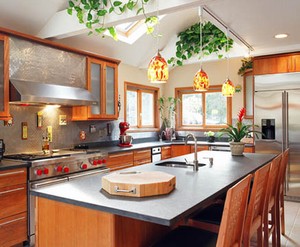News and Events
February 14, 2008

Mixing Styles Together in the Kitchen
by Doug Bolton
HomeOwnerNet Columnist
(ARA) - Though an eclectic
design looks easy to accomplish - a little bit of this and little bit of that,
it's actually one of the most difficult looks to successfully achieve.
What is eclectic? It is a
vibrant, individual style that doesn't adhere to any one major style or rule.
It is a comfortable mix-and-match attitude; it's the yin and yang of design
style that must be met with balance. It is not a jumble of whatever catches
your eye.
Typically, eclectic is a combination of two major design
styles such as contemporary, traditional, casual or Asian. It takes a lot of
careful planning, good taste and an eye for stylish design to make it work. A
great start in identifying your favorite styles is to clip magazine pictures
and keep them in your wish file. Consult a certified kitchen designer to help
you tie your favorite styles together.
One of the most effective ways
to achieve the eclectic look is with custom cabinetry. Because custom cabinetry
is made specifically to your specifications, you can control the look and feel
of each piece. A custom manufacturer, such as Plain & Fancy Custom
Cabinetry, which has been crafting custom cabinetry for over 35 years, can
craft cabinetry in just about any style imaginable. They do not carry any
inventory; each kitchen is built to the homeowner's specifications.
"Everyone has their own
style. We're seeing a mix of styles in one design," said Vince Achey, VP
of sales and marketing for Plain & Fancy Custom Cabinetry. "With
custom cabinetry, unlike stock cabinetry, you can have several different
doorstyles, colors and wood species all in one kitchen space. It's all about
what you want."
Once you identify your styles,
you must have a working knowledge of the five basic design principles: line,
color, texture, mass and form. Understanding the principles is the key to
making an eclectic design fabulous.
Line. Line creates movement and directs
the eye. Lines can be straight, curvy, horizontal, diagonal or vertical. All of
the elements in a room may offer line: the architecture, fabrics, furniture,
appliances and especially cabinetry. Cabinetry lines can be used to move the
eye towards the work area, the eating area or even into another room. Be
careful, too many lines can make the space feel busy and confusing but too few
lines can leave it feeling empty and unfinished.
A balance of high and low base
cabinetry can direct the eye to an architectural feature such as a skylight or even
a fabulous piece of art. For example, use a low bump out cabinet with a wooden
block top for cutting veggies to complement a higher marble top cabinet used
for making candy. Different cabinet depths can also move the eye around the
room with a balance of in and out.
Color. Eclectic design works best when the
elements relate in some fashion. Try combining different shades of the same
color on different pieces of cabinetry. Use a base color of creamy vanilla with
a coffee piping detail on very traditional wall units, but balance it on a
sleek contemporary island done in the same tone of cream but with a coffee
glaze. Though the pieces differ in style, they relate to each other through
color. Mixing wood species and tones is another way to connect elements. Use
grandmother's antique maple sideboard with your contemporary wenge cabinets.
"A custom cabinetry shop
will be able mix and match finishes and wood species for your desired
effect," said Achey. "At Plain & Fancy Custom Cabinetry we have a
department specifically dedicated to custom colors. About 25 percent of the
finishes we do each year are custom colors."
Texture. Texture can be used to create
balance and connection. Texture adds visual interest. The texture of a rustic
antique armoire juxtaposed to refined, smooth enameled cabinetry is quite
striking. This typifies the yin and yang aspect of eclectic design.
Form. This refers to the actual shape of
the elements of the room. The walls, furniture, doorways, accessories and
appliances all have form. If the room is tall and slender, then the best choice
for cabinetry should be tall and slender. The elements' form should echo the
form of the room's architecture - no matter what the decorating style.
Taking the five principles
into account, today's sense of style, desire for personal expression and the
need for functionality all create the perfect foil for an eclectic kitchen. Use
old with new, mix tones and colors, combine rough natural elements such as
stone with smooth marble or primitive art with contemporary cabinetry.
Remember, eclectic is about balance that creates character, beauty and fun.
Article courtesy of ARA
Content
About the Author
Doug Bolton is the owner of Homerwood Hardwood Floors located in the heart
of the








